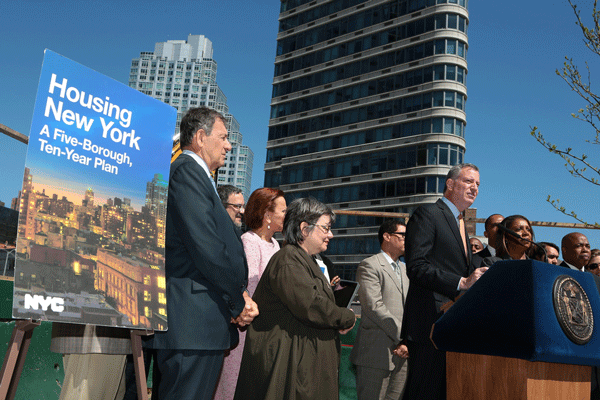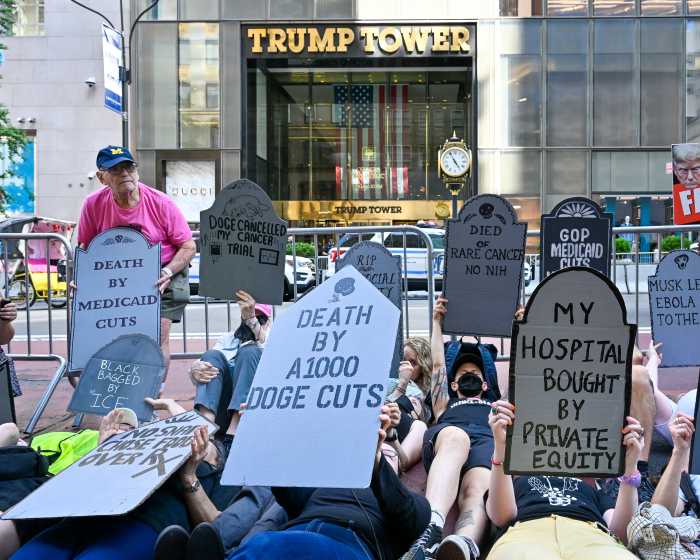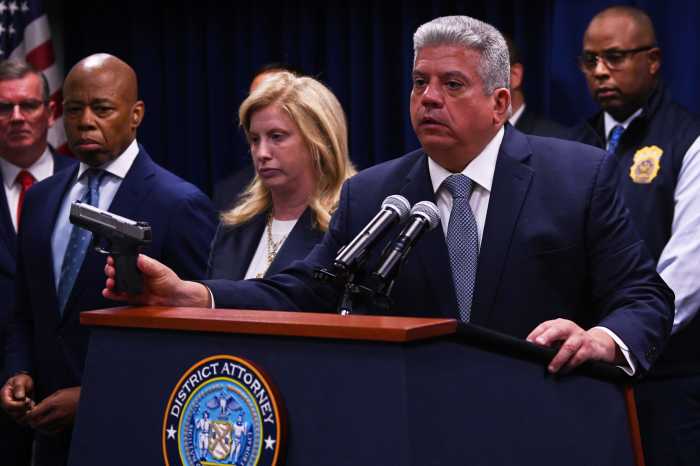
At an affordable housing construction site in Fort Greene, Mayor Bill de Blasio announces the bold goals of “Housing New York: A Five-Borough, Ten-Year Plan.”
BY EILEEN STUKANE | Mayor Bill de Blasio’s workweek began with the unveiling of an ambitious, long-awaited initiative that won’t be fully realized for another decade. While making stops in Brooklyn and the Bronx on May 5, de Blasio held up his 115-page “Housing New York: A Five-Borough, Ten-Year Plan” to protect and expand affordable housing.
He did not hold back: “This is literally the largest and most ambitious affordable housing program initiated by any city in this country in the history of the United States of America. It is the largest, fastest affordable housing plan ever attempted at the local level.”
Addressing what he views as “an affordability crisis that we’ve never seen the likes of before,” the mayor plans to create or maintain 200,000 affordable units over the next 10 years — by constructing 80,000 new apartments and preserving 120,000 existing apartments, at a cost of $41 billion. The plan is to be financed by bringing in $30 billion from private investment, $2.9 billion in federal and state funds and $8.2 billion from city funding (which includes $6.7 billion in capital dollars for direct housing subsidies). This is considerably greater in scope than former Mayor Bloomberg’s 165,000 affordable units over 12 years, with 66 percent of them preserved units.
To help meet his goal, de Blasio is not simply encouraging developers to offer affordable units in new buildings: he is requiring it. Under Bloomberg, the inclusion of affordable units by developers was voluntary — but by making that choice, developers gained tax credits and enjoyed other incentives such as the ability to build bigger. Units were usually offered on an 80/20 basis, with 20 percent of them affordable. “The 80/20 model was the model of the past,” de Blasio said at his announcement, adding, “The model we have now is to maximize affordability in each and every situation. Every situation is different. Every site is different.” He spoke in front of a construction site in Fort Greene, where 30 percent of the units were earmarked for middle-income and 20 percent for lower-income affordable housing.
In its response to the “Housing New York” plan, the Association for Neighborhood and Housing Development (ANHD) noted that the mayor’s plan “promises to serve four times as many extremely low-income New Yorkers as have been served in the previous 12 years…the city has acknowledged that because of the way Federal Income Limits are designed, the official ‘low-moderate- and middle-income’ bands are actually much higher than real New York City incomes.”
This recognition is an important breakthrough by a New York City administration. De Blasio noted that what’s considered 50 percent of Area Median Income (AMI) is $41,000 for a family of four. “That’s obviously a family that is really struggling to make ends meet here in New York City,” he said.
However, de Blasio’s plan for more affordable housing would create higher, denser neighborhoods through rezoning and mandatory inclusionary zoning, and building would take place on “underused” city land. The question arises of how these changes will affect quality of life in existing neighborhoods where open space is scarce.
“The key is just getting the right deal for the community,” says Moses Gates, program director at ANHD. “Public subsidies in city land should all be going to the local not-for-profit developers, not given away to for-profit developers,” he asserted. “If you’re going to build neighborhoods, you have to partner with those already-existing neighborhoods, make sure that neighborhood community groups are part of the entire plan all the way through, from early planning through construction and ownership.”
Community Board 4 (CB4), which aggressively pursues affordable housing through its own negotiation process with developers, has already digested the “Housing New York” plan and is making adjustments accordingly.
Joe Restuccia, co-chair of CB4’s Housing, Health and Human Services Committee, and executive director of Clinton Housing Development Company, reports that the committee has created a 47-slide PowerPoint presentation — while Christine Berthet, chair of CB4, has developed a digital map of the CB4 community. A comprehensive site-by-site inventory and analyses of locations that have been historically committed for use, or are already under construction, or require specific actions, is fully under way.
A community forum will be held in June and the final adoption of CB4’s work will take place in July. Recommendations will then be sent to the Mayor. “We’re trying to join our work with the Mayor’s work on a citywide level,” said Restuccia, “The goals are out there. Now it’s a question of how are we going to get to those goals.”
To access “Housing New York: A Five-Borough, Ten-Year Plan,” visit nyc.gov/html/housing/assets/downloads/pdf/housing_plan.pdf. Date and venue information for the June CB4 forum will be announced, on their website: nyc.gov/mcb4.

































